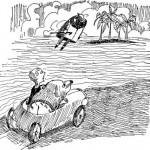I've always been tempted to use the Law and Order 'Clang' as the on-load sound for my site.
I’ve been thinking of how to engage more of a participant’s senses as they read printed content. I’d really like to figure out a way to go beyond the standard tricks or video clips and animated text.
If you are not familiar with the term, a music cue is the use of sound, usually musical, to signal a performer to “carry out an action or deliver a line.” However, the practice has evolved quite a bit. We frequently hear certain types of music to introduce a moment or event in a movie. Such a modern musical cue might be a deep thumbing tone for the villain or a quick jaunty tune for the jester.
In the golden age of sitcoms the use of stings became common. Strings are a certain bit of music used on a regular basis to signal the entry of a character or the end of a scene. Sometimes particular stings are used to identify people or types of events.
There was one big reason why musical stings became popular. They made viewers more aware of what was going on in a show without necessarily looking at the TV. You could be eating dinner or washing dishes and when a certain tone played, you’d know to look up and pay full attention to the screen.
Of course, it was no coincidence that a sting would occur right before a dramatic climax or end of the scene. In other words, right before the advertisements.
In the early days of internet media, advertisements exploited our tendency to pay attention when a particular sound played. Mostly these were pop-up ads. This was a horrible idea for many reason, it couldn’t be turned off. It was annoying. The sounds were tied to advertisements and there was really no other sound on the internet, or even your computer, and participants quickly stopped being fooled.
Since that greedy misstep, no has really tried to integrate sound into our browsing experience again. I wonder, if The New York Times had started playing sounds first, would we be using an internet with an ecosystem of sound?
So what options are open to us now?
Well, quite a few. We’d want to make it clear what was going on so that people could mute a site before it started playing, but we could still bring music into the browser.
Video games have played with adaptive music for years now. With adaptive code, music can change beat and tone automatically when certain events occur.
Perhaps pages could include some soft, low-key, background music that flourishes or goes into double-time when the user hits a trigger? Another alternative might simply be a few stings played when users mouse-over a link. The sound would alert them to important elements on a page.
Sound could be triggered by:
- mouse-overs
- scrolling to a certain place on a page
- clicking through a pagination link
- timers
- focusing on a window
- other types of interaction, like highlighting.
- key shortcuts
I imagine any site that implemented this would have some sort of standard controls in a small floating div alongside articles. It’s very important that it be optional and that participants have full control over volume and whether or not music is playing. It would be really cool if participants could decide the genre of music as well.
I’d love to give it a try on this site, but I don’t know how to implement it. I’ll give it a try if anyone else can figure it out though.
Trying to reach out to the sound part of our brain would be a great way to increase attention and engagement. I think it is worth a try at least. Let’s bring a bit of music to our online reading.
Can you think of any other ways to incorporate more sound into our browsing experience?































[…] This post was mentioned on Twitter by Aram Zucker-Scharff, Michael Galvin. Michael Galvin said: RT @Chronotope: Can we incorporate music into the browser experience? Can we use it to bring participants to attention? http://aramzs.me/2j […]
[…] you may remember, I’ve been thinking about the potential of audio to enhance content. Specific audio can trigger memories, feelings or emotions because of what we associate with them. […]